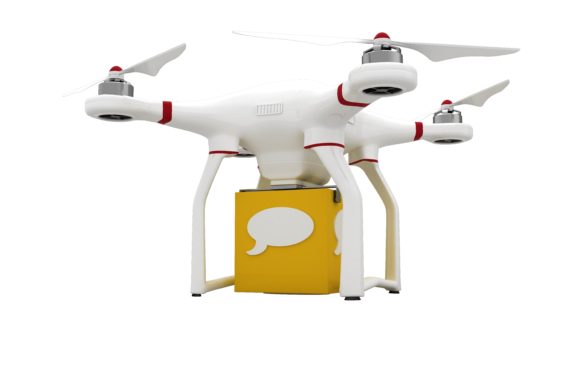A long-awaited framework for allowing drone flights over people — a key step in the growth of the industry — has been put on hold because of security concerns, prompting fears that the standards will get caught up in the Trump administration’s anti-regulatory push.
The dreams of companies such as Amazon.com Inc. to deliver packages via drone or of mobile-phone companies to check their towers in urban areas with them depends on the Federal Aviation Administration crafting this new rule.
The FAA failed to meet a promised deadline of issuing the rules by the end of 2016 as the agency encountered objections from law enforcement. Industry now may face further delay as President Donald Trump put a hold on all new regulations pending a review by the White House.
“There was a lot of frustration,” Lisa Ellman, a lawyer at Hogan Lovells US LLP who co-directs the Commercial Drone Alliance, which represents companies including Time Warner Inc.’s CNN cable network. “It’s counter intuitive to think that rules will create economic activity, but in this case it does.”
While business groups often oppose regulations because they impose what are seen as costs or burdensome requirements on companies, the drone industry has done the opposite. It broadly supports new regulations from the FAA. Without new regulations to expand how drones can be used, the industry can’t grow and may lose its competitive edge to non-U.S. companies, they argue.
FAA Administrator Michael Huerta told a trade show this month that the proposed rule’s release was postponed while officials worked with other agencies over issues related to law enforcement.
Currently, almost all drone flights over people’s heads are prohibited because of fears that the craft aren’t reliable enough to ensure that they won’t plummet into crowds and cause injuries. A regulation allowing flights over people is needed before they could be used for a wide range of commercial activities in populated areas.
“None of this makes any sense to me,” said Michael Drobac, head of the Washington-based Small UAV Coalition, a drone advocacy group that includes Alphabet Inc., Amazon.com Inc. and Intel Corp. among its members. UAV refers to unmanned aerial vehicle. The FAA plans to release a proposed rule, which would would have given national security and law enforcement agencies a chance to raise their concerns before the rule became final, he said.
Drone-advocacy groups have been in contact with officials associated with the Trump administration to urge them to move forward, Drobac and Ellman said.
Regulations Welcomed
The world’s largest drone manufacturer, China’s SZ DJI Technology Co., believes “new regulations are very welcome,” Brendan Schulman, the company’s vice president for policy and legal affairs in the U.S., said in an interview.
While the proposed new regulations aren’t expected to immediately darken the skies with hovering drones, they would lay the ground work for expanded flights by companies like Amazon that are trying to perfect automated unmanned package delivery and other businesses such as utilities and the news media.
An advisory panel of drone and aviation industry representatives last year recommended that the FAA adopt a tiered approach to unmanned flights over people.
The group suggested creating a category of micro drones weighing no more than about a half pound (250 grams) that could fly near people because they were so light they couldn’t harm anyone.
Close Encounters
Larger drones would be permitted over people under a variety of arrangements designed to ensure no one could be hurt, such as by setting impact standards, limiting how close they can come to crowds and ensuring reliability, the group recommended.
Speaking Jan. 6 at the consumer electronics show CES 2017, the FAA’s Huerta said security issues were chiefly the reason for the rule’s delay.
“As drone flights over people become more and more common place, imagine the challenge of a local police officer who is trying to determine which drones are properly there to photograph the festivities and which might be being operated by individuals with more nefarious purposes,” he said.
Working with other U.S. agencies to iron out these issues “is taking time,” he said. In addition, meetings with people in the unmanned industry had raised unspecified additional issues that needed ironing out, he said. The FAA is working as quickly as it can to get the rules published, Huerta says.
The FAA didn’t respond to requests for further comment this week.
Related:
- Law Enforcement, Private Firms Look to Evolving Drone Defense Industry for Protection
- Drone Makers Shift to Commercial Uses as Consumer Market Crashes
- The Future of Commercial Drone Use
- Report Criticizes FAA Safety Oversight of Drones as Lax
- FAA Creates Drone Advisory Panel, Lifts Barrier to Education
- U.S. Issues Final Regulation for Small Commercial Drones
- Case Testing FAA Authority to Regulate Drones Advances
Topics USA Legislation Aviation
Was this article valuable?
Here are more articles you may enjoy.



 Former CEO of Nonprofit P/C Statistical Agent Sentenced for Stealing Millions
Former CEO of Nonprofit P/C Statistical Agent Sentenced for Stealing Millions  Grand Jury Declines to Indict Man in Fatal Shooting at Kentucky State University
Grand Jury Declines to Indict Man in Fatal Shooting at Kentucky State University  CEO Sentenced in Miami to 15 Years in One of the Largest Health Care Fraud Cases
CEO Sentenced in Miami to 15 Years in One of the Largest Health Care Fraud Cases  Severity Was Up, But Will Falling Claims Volume Impact the Profession?
Severity Was Up, But Will Falling Claims Volume Impact the Profession? 

